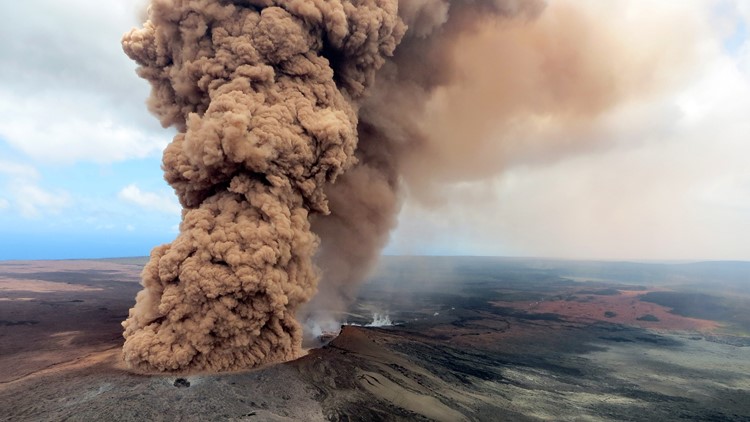You can't stop the lava flow from Hawaii — Millions of people seeing images of lava destroying homes, cars and power poles have a simple question for authorities: Why can’t you stop it?
Try spraying lava with water, some suggest. Maybe dig a ditch to divert the flow or erect a barrier? How about explosives? Can’t they change its course?
No. No. And no.
“It’s a heartbreaking situation because these are people’s homes. Everyone in the volcanology community is just heartbroken. But from a scientific perspective, we know there’s just no way to divert this lava flow,” said Shannon Kobs Nawotniak, an associate professor of geosciences at Idaho State University and a NASA researcher.
Here's the problem: Lava isn't like water, snow or mud. It's liquid rock, so it's heavy, sticky and moving underground. And it's also nearly 2,000 degrees.
The highest-profile time that authorities successfully diverted a lava flow was for a slow-moving flow in Iceland threatening a harbor. For five months in 1973, workers doused the front of the flow with ice-cold seawater until it ground to a halt. That effort required 1.5 billion gallons of water, the equivalent of 2,200 Olympic-size swimming pools.
Building ditches or diversion channels might also work, but the investment and labor required would almost certainly outweigh the overall costs of the lava damage and also put more people in harm's way of the flow, Nawotniak said.
Besides, lava doesn't really behave the way it does on the big screen: Nawotniak said lava is so dense that if your shoes wouldn't melt, you could probably walk atop the molten flow. The military has tried using explosives to divert lava flows, but that didn't really work either.
Instead, the best solution is to evacuate the area and wait until the flows stop on their own, experts said.
“Most people’s orientation on this kind of thing comes from movies. It’s a common enough trope in movies that we forget how unrealistic that is," she said. “You’re not going to sink into it like Gollum in Lord of the Rings. It’s really not like that. It’s slow-moving and inexorable and strong, but it’s not going to suck things down.”

The reality of the situation isn't lost on Hawaiian authorities or the people who chose to live in Leilani Estates. Here, everyone knows the risk is real, largely because the evidence is all around them.
Cooled lava rocks from past flows are visible everywhere, and Pahoa's entrance sign is made of chunks of a lava rock known as A'a', a rough cinder-like heavy pumice. In 1990, a lava flow from the same volcano, Kilauea, destroyed the nearby town of Kalapana. Today, the area is largely deserted and looks like someone paved over it with lumpy asphalt, a reminder that Pele, the Hawaiian volcano goddess, rules here.
For longtime residents, the memory of Kalapana remains fresh, even though workers bulldozed the cooled A'a' and Pahoehoe lava off some of the roads.
Nearby Hawaii Volcanoes National Park has also contended with periodic lava flows, and park spokeswoman Jessica Ferracane said the lava itself isn't the problem. The struggle, she said, is that people choose to live in and visit areas where lava flows.
"Trying to shape the landscape to fit our needs is the real challenge," she said.
Land in the lava flow zones is cheap, however: A small plot of land can cost as little as $7,500. Inside Leilani Estates, there's a one-acre plot available for $18,995, and the sales listing made about 10 days ago makes no mention of the potential danger. That property now appears to be covered in fresh lava, according to government maps.
Because there's little authorities can do to change the lava's flow, they instead focus on evacuation preparedness and public awareness of the danger.
At a community meeting Monday night, Gov. David Ige and Hawaii County Mayor Harry Kim said residents must understand that the danger from the lava and toxic gases is very real and may continue indefinitely. The flow that erupted inside the Leilani Estates neighborhood has destroyed at least 35 structures, including 26 homes, authorities said.
"Obviously it's very different when you have it happen," said Ige, an engineer by training. "It's heartbreaking to watch the residents deal with it, (but) I think they know and understand that Madam Pele decides who will be impacted."
Emotions have been running high in the area as frustrated evacuees struggle to retain a sense of normalcy in the community they call home even if they're unable to return to their houses. Their frustration with the lava's destruction is evident, although they place no blame on authorities for being unable to stop the flows that erupted from 12 vents beneath their neighborhood.
"Arrgghh," evacuee Dana Donovan said. "I just planted flowers."
During Monday night's community meeting, Kim pleaded with residents for patience. Authorities are now allowing evacuees daily access to their homes in the Leilani Estates area as long as they remain only briefly and heed any new evacuation warnings. Scientists said the lava activity was significantly quieter on Monday compared to Sunday, although they warned that could change at any moment.
"Every decision we make is to keep you safe. We commit that to you," Kim said. "Pele has given us the grace of quiet for today. But we don't know what tomorrow will bring."



